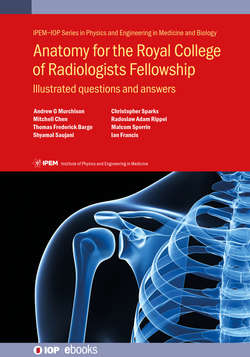Читать книгу Anatomy for the Royal College of Radiologists Fellowship - Malcolm Sperrin - Страница 22
На сайте Литреса книга снята с продажи.
Q1.14 Parasagittal T1-weighted sequence from an MRI head
Оглавление1 Name the arrowed structure.
2 Name the arrowed structure.
3 Name the arrowed structure.
4 Name the arrowed structure.
5 Name the arrowed structure.
Answers
1 Cingulate sulcus.
2 Parietal lobe.
3 Parieto-occipital sulcus.
4 Calcarine sulcus.
5 Cingulate gyrus.
Comments:
There are four lobes within each brain hemisphere. The frontal lobe is the largest, and is separated from the parietal lobe by the central sulcus. The pre-central gyrus (motor strip) is part of the frontal lobe immediately anterior to the central sulcus, and is responsible for motor control. The post-central gyrus is immediately posterior to the central sulcus and contains the primary sensory cortex.
The parieto-occipital sulcus lies between the parietal lobes and the occipital lobes. The visual cortex is situated on both sides of the calcarine sulcus, which sits in the middle of the occipital lobe, and joins with the parieto-occipital sulcus medially.
The temporal lobes are located laterally—they are separated from the frontal lobes by the Sylvian fissure anteriorly and are continuous with the parietal and occipital lobes posteriorly.
It is also important to recognise the paired cingulate gyri (which lie immediately above the corpus callosum) and the cingulate sulci superior to them.
Exam tip:
If possible, be specific when naming parts of the cerebral cortex, e.g. by giving the answer ‘superior frontal gyrus’ rather than ‘frontal lobe’ on an appropriate coronal image. However, sometimes it isn’t possible to be more specific, as with the parietal lobe question above—in that case, give the name of the lobe.
